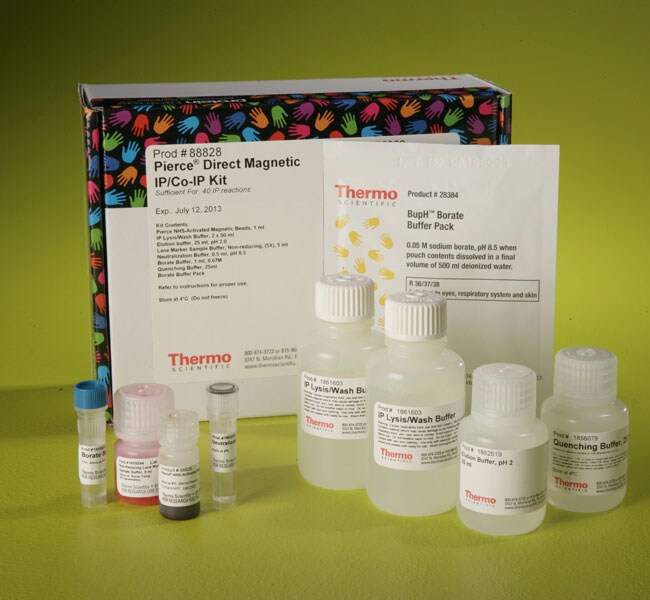
Thermo Scientific Pierce Direct Magnetic IP/Co-IP Kit uses NHS-chemistry to covalently immobilize IP antibodies onto magnetic beads for effective immunoprecipitation and co-immunoprecipitation.
Magnetic IP with NHS chemistry is convenient and allows for the immobilization of IP antibody from any species and subtype without the variations in coupling efficiency seen with Protein A and Protein G. The IP antibody is covalently attached so target proteins or co-IP protein complexes can be eluted and analyzed without antibody contamination. The kit contains an optimized protocol and all buffers and reagents necessary for antibody coupling and high yield IP or co-IP using either manual magnetic stands or automated platforms such as the Thermo Scientific KingFisher Instruments.
Features of the Direct Magnetic IP/Co-IP Kit:
• Antibody-free IP—antibody is irreversibly attached to the magnetic beads, resulting in negligible co-elution of intact antibody or heavy and light chains with the purified antigen
• Fast—complete antibody conjugation and immunoprecipitation in less than 4 hours
• Convenient—the IP/co-IP kit contains magnetic beads and all essential buffers for optimal immunoprecipitation
• Antibody compatible—use with any antibody species, class or isotype
• Low nonspecific binding—the bead surface is pre-blocked and all nonreacted NHS-ester groups are fully quenched
• Protocol-compatible—protein coupling to the beads and immunoprecipitation can be performed manually or by automation (e.g., Thermo Scientific KingFisher Instruments)
• Scalable—use only the amount of antibody needed for a single IP experiment or prepare a larger quantity of antibody magnetic beads for multiple experiments
The protocol for the Pierce Direct IP/Co-IP Kit conjugates IP antibody to Pierce NHS-Activated Magnetic Beads through NHS-ester chemistry. The antibody-bound beads are then incubated with quenching buffer to block remaining active NHS sites. The prepared antibody-bound beads are incubated with cell lysate or tissue extract that contain the protein antigen of interest, allowing the antigen:antibody complex to form. The beads are washed to remove nonbound material and a low-pH elution buffer is used to dissociate bound antigen from the antibody-bound bead. Neutralization buffer is included to prevent precipitation of the isolated antigen and to ensure protein activity in downstream applications. Lane Marker Sample Buffer is included for preparing samples for SDS-PAGE analysis. The protocol is optimized for 2 to 10μg of IP antibody per assay. For optimal co-IP yields, use 10μg of antibody. The beads can be processed manually using a magnetic stand or by automation with an instrument such as the Thermo Scientific KingFisher Flex.
Traditional IP with Protein A/G Magnetic Beads, involving passive, noncovalent coupling of antibody with Protein A/G typically provides higher antigen yields than IP protocols that involve covalent attachment of antibody to magnetic beads through crosslinking or NHS-ester chemistry. Covalent attachment inevitably causes loss of some functional antibody binding sites. To overcome this limitation with NHS-chemistry, it may be necessary to use larger amounts of IP antibody in the direct IP method than in the traditional IP method. The advantage of immunoprecipitation with IP antibody covalently bound to the magnetic bead is Western blots and gels devoid of interfering antibody bands.
Related Products
Pierce™ Direct IP Kit
| Code | Description |
|---|---|
| 88828 | Catalog Number: 88828 |

